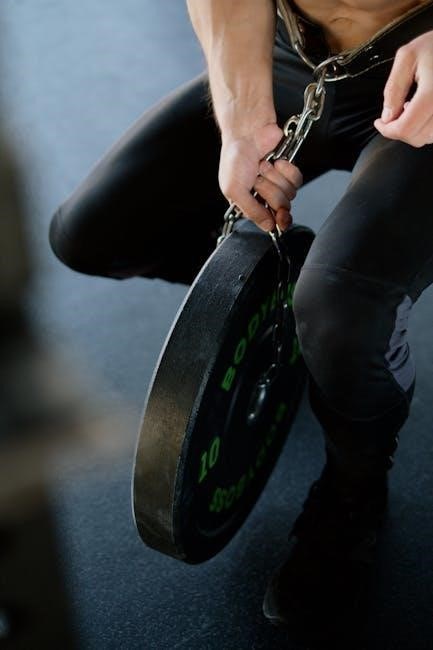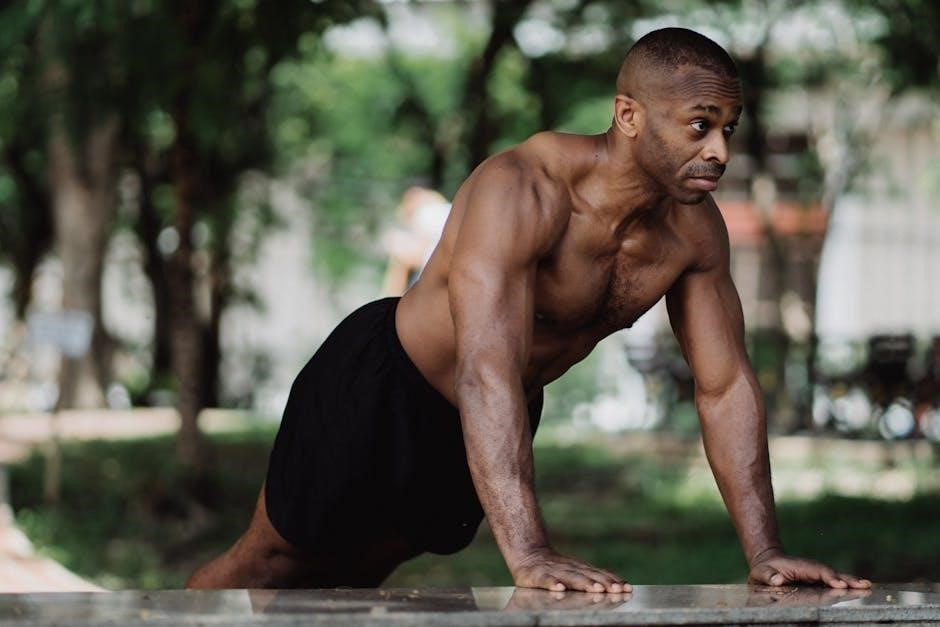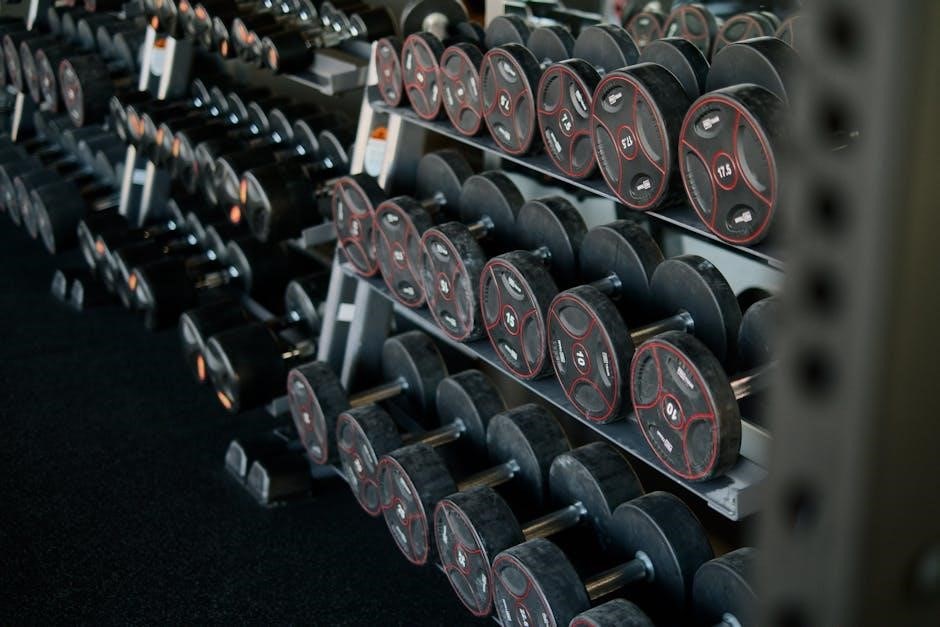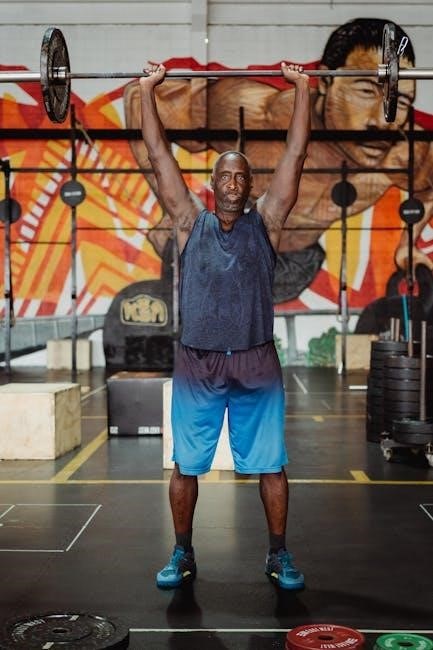Discover the transformative power of somatic workouts with our free PDF resources. These guides offer gentle, effective exercises to improve posture, reduce stiffness, and release tension.
Definition of Somatic Workouts
Somatic workouts are a form of movement practice that focuses on enhancing body awareness and improving mobility through gentle, intentional exercises. Rooted in the concept of somatics, these workouts emphasize the internal experience of movement rather than external performance. By engaging the mind-body connection, individuals can release chronic muscle tension, improve posture, and restore natural movement patterns. Somatic exercises often involve slow, controlled movements, breathing techniques, and mindful attention to sensations in the body. Unlike traditional workouts, somatic practices are more about education and awareness than physical exertion, making them accessible to people of all ages and fitness levels. The goal is to empower individuals to take ownership of their physical well-being and move with greater ease and freedom.
Benefits of Somatic Exercises
Somatic exercises offer numerous benefits, including enhanced body awareness, improved flexibility, and reduced muscle tension. These practices help alleviate chronic pain, restore proper posture, and promote relaxation. By fostering a deeper connection between the mind and body, somatic movements can enhance overall physical and emotional well-being. They are particularly effective for addressing issues like back pain, sciatica, and limited mobility. Regular practice can also improve coordination, balance, and range of motion. Additionally, somatic exercises are low-impact, making them suitable for individuals with injuries or chronic conditions. They empower individuals to take an active role in their health, leading to a more balanced and pain-free lifestyle. The gentle, mindful nature of these exercises makes them accessible to people of all ages and fitness levels.
Importance of Mind-Body Connection
The mind-body connection is central to somatic workouts, as it enables individuals to tune into their internal sensations, fostering awareness and control over their movements. This connection allows practitioners to identify and release unnecessary muscle tension, promoting relaxation and efficiency in movement. By engaging the brain in the process, somatic exercises enhance neuroplasticity, the brain’s ability to adapt and change. This heightened awareness improves posture, reduces pain, and enhances overall physical and emotional well-being. The mind-body connection also empowers individuals to take an active role in their health, making somatic practices deeply transformative. It bridges the gap between mental intention and physical response, creating a holistic approach to movement and healing. Regular practice strengthens this connection, leading to greater body intelligence and a more integrated sense of self.

The Science Behind Somatic Workouts
Somatic workouts rely on the nervous system’s role in movement and sensation, focusing on pandiculation to release tension and enhance neuromuscular communication for optimal body function.
The Role of the Somatic Nervous System
The somatic nervous system (SNS) plays a central role in somatic workouts by regulating voluntary movements and sensory perceptions. It connects the brain to muscles and sensory receptors, enabling conscious control over the body. Somatic exercises target the SNS to release physical tension, improve flexibility, and enhance body awareness. By focusing on gentle, intentional movements, individuals can retrain their nervous system to break cycles of chronic tension. This process restores natural movement patterns, reducing pain and improving posture. The SNS’s ability to adapt and learn makes it a key component in achieving long-term benefits from somatic practices. Understanding its function is essential for maximizing the effectiveness of somatic workouts and achieving a deeper mind-body connection.
Understanding Pandiculation
Pandiculation is a natural, instinctive movement pattern that involves contracting and releasing muscles to reset tension and improve flexibility. It is a key concept in somatic workouts, mimicking the way animals stretch to release tension. During pandiculation, muscles are contracted gently and then released slowly, allowing the nervous system to recalibrate and release chronic tension. This process enhances proprioception, or body awareness, helping individuals regain control over tight muscles. Regular practice of pandiculation can improve posture, reduce pain, and restore natural movement patterns. Unlike stretching, which focuses on lengthening muscles, pandiculation targets the nervous system’s role in maintaining tension, making it a uniquely effective approach in somatic education. Incorporating pandiculation into your routine can lead to lasting relief and improved overall mobility.
The Concept of Muscle Tension and Relaxation
Muscle tension and relaxation are fundamental principles in somatic workouts, focusing on the body’s ability to release unnecessary contraction and restore natural movement. Chronic tension often arises from unconscious habits, stress, or past injuries, leading to stiffness and discomfort. Somatic exercises teach individuals to identify and release this tension by engaging the mind-body connection. Unlike traditional stretching, somatic movements emphasize slow, intentional contractions followed by relaxed releases, allowing the nervous system to relearn healthy muscle patterns. This process enhances flexibility, reduces pain, and improves posture. By understanding and addressing muscle tension, practitioners can achieve a more balanced and relaxed state, fostering long-term physical well-being and ease of movement. This approach is gentle, sustainable, and deeply restorative, making it accessible to everyone.

Key Figures in Somatic Education
Thomas Hanna and Moshe Feldenkrais are pioneers, developing groundbreaking methods that transformed somatic practices, enhancing body awareness and movement efficiency for overall well-being.
Thomas Hanna and His Contributions
Thomas Hanna, a philosopher and somatic therapist, revolutionized the field by developing Clinical Somatic Education. His work emphasizes awareness and movement to release chronic tension. Hanna’s approach focuses on pandiculation, a natural process of contracting and releasing muscles to restore flexibility and ease. He also introduced the concept of “sensory motor amnesia,” where muscles forget how to relax, leading to pain and stiffness. Hanna’s techniques are widely used to address issues like chronic pain and poor posture. His book, The Body of Life, provides insights into his methods. By focusing on mind-body connection, Hanna’s contributions have empowered individuals to take control of their physical well-being through gentle, intentional movements. His legacy continues to inspire modern somatic practices, offering a holistic approach to health and mobility.
Moshe Feldenkrais and His Method
Moshe Feldenkrais, a physicist and martial artist, developed the Feldenkrais Method, a groundbreaking approach to somatic education. His work focuses on improving movement, posture, and overall well-being by enhancing body awareness. Feldenkrais believed that by gently guiding individuals through specific movements, they could relearn efficient patterns of motion, reducing pain and improving flexibility. His method emphasizes the connection between the brain and body, encouraging individuals to explore their full potential through mindful, non-invasive exercises. The Feldenkrais Method is widely used to address chronic pain, improve coordination, and enhance quality of life. It stands out for its holistic approach, making it accessible to people of all ages and abilities. Feldenkrais’s legacy continues to inspire somatic practitioners and educators worldwide. His teachings remain a cornerstone of modern somatic practices.
Modern Practitioners and Their Approaches
Modern practitioners of somatic education continue to evolve the field, blending traditional methods with contemporary insights. Many focus on making somatic workouts accessible to diverse populations, incorporating digital tools and online resources. Some practitioners emphasize the integration of somatics with mindfulness and meditation, while others specialize in addressing chronic pain or improving athletic performance. They often create tailored programs for individuals with specific needs, such as postural correction or stress relief. These modern approaches highlight the adaptability of somatic principles, ensuring they remain relevant in today’s fast-paced world. By combining timeless techniques with innovative delivery methods, modern practitioners are expanding the reach of somatic workouts, making them more inclusive and effective than ever before. Their work inspires a new generation to embrace somatic practices for overall well-being.

Popular Somatic Exercises
Popular somatic exercises include the cat-cow stretch, neck releases, and hip flexor releases. These gentle movements enhance flexibility and reduce muscle tension, promoting deep relaxation and improved posture.
Basic Feldenkrais Lessons
Basic Feldenkrais lessons focus on gentle, mindful movements designed to enhance body awareness and flexibility. These foundational exercises improve posture, reduce muscle tension, and boost coordination. By engaging the brain’s motor learning centers, they help retrain movement patterns for greater efficiency and comfort. Many lessons are floor-based, using mats for support, and involve slow, controlled actions that encourage deep relaxation and breathing. Popular beginner exercises include shoulder rolls, spine waves, and hip rotations. These lessons are ideal for those new to somatic practices, as they build a strong foundation for more advanced movements. Free PDF guides often include step-by-step instructions, photos, and tips for practicing Feldenkrais at home, making it accessible to everyone.
Advanced Somatic Movements
Advanced somatic movements are designed for individuals who have mastered the basics and seek deeper body awareness and efficiency. These exercises often involve dynamic, flowing sequences that integrate multiple body parts, enhancing coordination and flexibility. Techniques like spinal waves, leg swings, and arm circles are common, focusing on releasing tension in complex patterns. They target areas such as the pelvis, shoulders, and hips to restore natural movement. Advanced movements also emphasize mindful transitions, encouraging the brain to adapt and improve motor skills. Free PDF resources offer detailed guides, including visuals and instructions, to help practitioners progress safely. These exercises are ideal for addressing chronic pain or improving athletic performance, fostering a stronger mind-body connection and overall well-being.
Exercises for Specific Needs (Hips, Back, etc.)
Somatic exercises are highly adaptable, offering targeted movements for areas like the hips, back, and neck. For hip mobility, gentle lying leg stretches or seated hip rotations can release tension and improve flexibility. Back-focused exercises, such as the Cat-Cow stretch or spinal waves, enhance posture and reduce stiffness. Neck releases involve subtle head tilts and rotations to alleviate strain. Free PDF resources provide detailed routines tailored to these areas, often including step-by-step guides and images. These exercises are designed to address pain, improve alignment, and restore movement efficiency. They are accessible for all fitness levels and can be practiced at home, making them a practical solution for specific physical needs. By focusing on release rather than force, these movements promote lasting relief and enhanced mobility.

Free Somatic Workout PDF Resources
Discover free PDF guides offering somatic workout plans, exercises, and techniques for full-body wellness. Explore curated resources with detailed routines, perfect for beginners and experienced practitioners alike.
28-Day Somatic Workout Plan
A comprehensive 28-day somatic workout plan designed to guide you through daily exercises that enhance flexibility, posture, and overall body awareness. Each day focuses on specific muscle groups, with gentle, mindful movements to release tension and improve mobility. The plan is structured to gradually increase intensity, ensuring a safe and effective progression. Perfect for beginners and experienced practitioners alike, it emphasizes proper form and alignment; Includes tips for modifying exercises based on individual needs and goals; Weekly check-ins help track progress, encouraging consistency and self-awareness. This PDF resource is a great starting point for those new to somatic practices, offering a clear roadmap to achieving long-term wellness and body harmony.

10 Essential Somatic Yoga Exercises
Discover a curated selection of 10 essential somatic yoga exercises designed to enhance flexibility, balance, and breath awareness. These gentle, mindful movements target key areas such as the spine, hips, and shoulders, promoting relaxation and improved posture. Each exercise is crafted to foster greater body awareness and release deep-seated muscle tension. Perfect for all fitness levels, these practices emphasize slow, intentional movements that nurture both physical and mental well-being. The accompanying PDF guide provides detailed instructions, visuals, and variations to suit individual needs. By incorporating these exercises into your routine, you can experience the transformative benefits of somatic yoga, leading to a stronger, more balanced, and harmonious you.
Release the Trauma: 10 Somatic Exercises for Emotional Liberation
This powerful guide offers 10 somatic exercises specifically designed to release emotional trauma and foster inner peace. By focusing on gentle, mindful movements, these practices help reconnect the mind and body, allowing for the release of stored tension and emotional blockages. The exercises are rooted in the principles of somatic movement, emphasizing awareness and breath to create a safe space for healing. Each exercise is carefully crafted to promote self-regulation, resilience, and emotional freedom. The accompanying PDF provides step-by-step instructions, visual aids, and affirmations to support your journey. Whether you’re addressing past traumas or seeking emotional balance, these somatic practices offer a compassionate and empowering path to liberation.

How to Practice Somatic Workouts
To begin, create a structured routine using the 28-Day Somatic Workout Plan from the free PDF. Start by setting up a quiet, comfortable practice space that encourages focus and relaxation. Assess your specific needs, such as targeting hip or back tension, and select exercises accordingly. As you progress, pay attention to your body’s feedback to adjust your routine, ensuring it remains effective and enjoyable. Emphasize the mind-body connection by moving gently and mindfully, fostering awareness and release of tension. By following these steps, you can effectively incorporate somatic workouts into your daily life, promoting overall well-being and flexibility.
Setting Up Your Practice Space
Creating a conducive environment for somatic workouts is crucial for maximizing benefits. Begin by selecting a quiet, distraction-free area with a comfortable floor surface, ideally covered with a mat. Ensure the space is well-ventilated and maintained at a comfortable temperature to promote relaxation. Soft, natural lighting enhances focus, while a clutter-free zone minimizes distractions. Consider using pillows or blankets for support during exercises. Keep a water bottle nearby to stay hydrated. Avoid electronic distractions by turning off notifications. Refer to the free PDF resources for detailed guidance on optimizing your practice space. By thoughtfully setting up your area, you create an inviting atmosphere that supports mindfulness and effective somatic movement. This preparation ensures you can fully engage with each exercise, fostering a deeper mind-body connection and improved outcomes.
Choosing the Right Exercises for Your Needs
When selecting somatic exercises, it’s essential to tailor your choices to your specific goals and current physical state. Start by assessing your body’s areas of tension or discomfort, as somatic movements are designed to address these directly. Choose exercises that target your needs, such as improving flexibility, relieving chronic pain, or enhancing mobility. Consider your fitness level and progress gradually, ensuring you don’t overstrain. The free PDF resources, like the 28-Day Somatic Workout Plan, offer structured routines to guide your selection. Always prioritize movements that feel intuitive and gentle, as somatic workouts emphasize subtlety and awareness. This personalized approach ensures you maximize benefits while honoring your body’s unique requirements.

Tracking Progress and Adjusting Your Routine
Monitoring your progress in somatic workouts is crucial for long-term success. Begin by setting clear, achievable goals and documenting your baseline state, including physical sensations and mobility levels. Regularly assess improvements in flexibility, strength, and pain reduction. Pay attention to subtle changes, as somatic exercises often yield gradual yet profound results. Adjust your routine based on feedback from your body, replacing exercises that no longer challenge you with those that address new areas of tension. Use the free PDF resources, such as the 28-Day Somatic Workout Plan, to guide your adjustments and ensure a balanced approach. Celebrate small victories and remain patient, as consistency is key to lasting transformation. Tailor your practice to evolve with your body’s needs for optimal growth and well-being.

Common Misconceptions About Somatic Workouts
Some believe somatic workouts are too slow or ineffective, but they enhance mobility and reduce pain. Free PDFs debunk myths and clarify benefits.
Distinguishing Somatic Workouts from Other Practices

Somatic workouts differ from yoga, Pilates, or stretching by focusing on internal awareness and gentle, controlled movements to release chronic muscle tension. Unlike traditional exercises, somatic practices emphasize the mind-body connection, targeting the nervous system to restore natural movement patterns and reduce pain. They are not about intensity or external results but rather internal feedback and self-regulation. Free PDF resources often highlight these distinctions, offering clarity for those new to somatic work. While yoga may focus on holding poses and Pilates on core strength, somatic exercises prioritize awareness and release, making them unique in their approach to wellness. This subtle yet profound difference sets somatic workouts apart, appealing to those seeking long-term relief and improved mobility.
Addressing Concerns About Effectiveness
Some individuals may question the effectiveness of somatic workouts due to their gentle and subtle nature. However, these practices are deeply rooted in scientific principles, particularly the function of the somatic nervous system, which plays a crucial role in controlling voluntary movements and maintaining posture. By targeting the nervous system, somatic exercises can address the root causes of chronic pain and limited mobility. Many practitioners report significant improvements, such as reduced pain, enhanced flexibility, and better overall well-being. While results may vary, consistent practice is key to achieving lasting benefits. Free PDF resources often provide structured guidance, making it easier for newcomers to explore these exercises and experience their effectiveness firsthand. With patience and dedication, somatic workouts can lead to meaningful and sustainable changes in physical comfort and movement efficiency.
Understanding the Role of Feedback in Somatic Exercises
Feedback plays a vital role in somatic exercises, as it helps individuals tune into their body’s internal signals. This process involves paying attention to sensations, tensions, and movements to better understand how the body responds to specific actions. By fostering awareness, somatic practices encourage participants to use feedback to refine their movements and release unnecessary tension. Free PDF resources often include exercises designed to enhance this self-awareness, guiding users to recognize and interpret their body’s feedback effectively. This feedback loop allows for more precise and impactful movements, leading to improved flexibility, reduced discomfort, and a deeper connection to one’s physical form. Regular practice with attention to feedback can significantly enhance the effectiveness of somatic workouts, making them a powerful tool for long-term well-being.
Final Thoughts on Somatic Workouts
Somatic workouts are a powerful tool for reclaiming control over your body and mind. By focusing on gentle, mindful movements, these practices help release tension, improve flexibility, and enhance overall well-being. The availability of free PDF resources makes it easier than ever to incorporate somatic exercises into your daily routine. Whether you’re seeking relief from chronic pain or aiming to deepen your mind-body connection, somatic workouts offer a sustainable path forward. Consistency is key, as even short practices can lead to significant improvements over time. Embrace this journey with patience and curiosity, and discover how somatic movements can transform your relationship with your body.
Encouragement to Start Your Somatic Journey
Embarking on a somatic journey is a life-enhancing decision that empowers you to reclaim your body’s natural ease and vitality. With free PDF resources readily available, you can begin exploring somatic practices in the comfort of your own space. Start small—just a few minutes a day—to experience the profound benefits of mindful movement. Remember, somatic workouts are not about perfection but about reconnecting with your body and releasing unnecessary tension. Be patient and kind to yourself as you navigate this transformative process. Celebrate small victories, like improved posture or reduced pain, and let these milestones motivate you to continue. Your somatic journey is a personal path to wellness, and every step forward is a step toward a more vibrant, pain-free life. Take the first step today and discover the freedom your body deserves.



